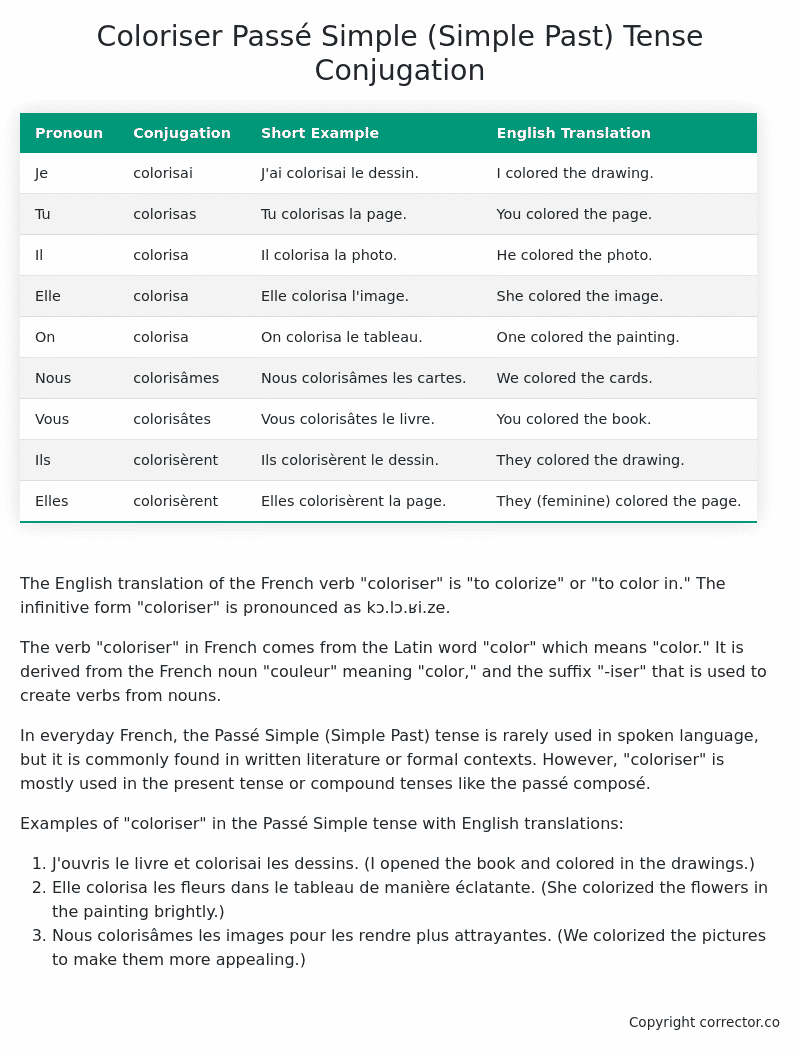Passé Simple (Simple Past) Tense Conjugation of the French Verb coloriser
Introduction to the verb coloriser
The English translation of the French verb “coloriser” is “to colorize” or “to color in.” The infinitive form “coloriser” is pronounced as kɔ.lɔ.ʁi.ze.
The verb “coloriser” in French comes from the Latin word “color” which means “color.” It is derived from the French noun “couleur” meaning “color,” and the suffix “-iser” that is used to create verbs from nouns.
In everyday French, the Passé Simple (Simple Past) tense is rarely used in spoken language, but it is commonly found in written literature or formal contexts. However, “coloriser” is mostly used in the present tense or compound tenses like the passé composé.
Examples of “coloriser” in the Passé Simple tense with English translations:
- J’ouvris le livre et colorisai les dessins. (I opened the book and colored in the drawings.)
- Elle colorisa les fleurs dans le tableau de manière éclatante. (She colorized the flowers in the painting brightly.)
- Nous colorisâmes les images pour les rendre plus attrayantes. (We colorized the pictures to make them more appealing.)
Table of the Passé Simple (Simple Past) Tense Conjugation of coloriser
| Pronoun | Conjugation | Short Example | English Translation |
|---|---|---|---|
| Je | colorisai | J’ai colorisai le dessin. | I colored the drawing. |
| Tu | colorisas | Tu colorisas la page. | You colored the page. |
| Il | colorisa | Il colorisa la photo. | He colored the photo. |
| Elle | colorisa | Elle colorisa l’image. | She colored the image. |
| On | colorisa | On colorisa le tableau. | One colored the painting. |
| Nous | colorisâmes | Nous colorisâmes les cartes. | We colored the cards. |
| Vous | colorisâtes | Vous colorisâtes le livre. | You colored the book. |
| Ils | colorisèrent | Ils colorisèrent le dessin. | They colored the drawing. |
| Elles | colorisèrent | Elles colorisèrent la page. | They (feminine) colored the page. |
Other Conjugations for Coloriser.
Le Present (Present Tense) Conjugation of the French Verb coloriser
Imparfait (Imperfect) Tense Conjugation of the French Verb coloriser
Passé Simple (Simple Past) Tense Conjugation of the French Verb coloriser (You’re reading it right now!)
Passé Composé (Present Perfect) Tense Conjugation of the French Verb coloriser
Futur Simple (Simple Future) Tense Conjugation of the French Verb coloriser
Futur Proche (Near Future) Tense Conjugation of the French Verb coloriser
Plus-que-parfait (Pluperfect) Tense Conjugation of the French Verb coloriser
Passé Antérieur (Past Anterior) Tense Conjugation of the French Verb coloriser
Futur Antérieur (Future Anterior) Tense Conjugation of the French Verb coloriser
Subjonctif Présent (Subjunctive Present) Tense Conjugation of the French Verb coloriser
Subjonctif Passé (Subjunctive Past) Tense Conjugation of the French Verb coloriser
Subjonctif Imparfait (Subjunctive Imperfect) Tense Conjugation of the French Verb coloriser
Subjonctif Plus-que-parfait (Subjunctive Pluperfect) Tense Conjugation of the French Verb coloriser
Conditionnel Présent (Conditional Present) Tense Conjugation of the French Verb coloriser
Conditionnel Passé (Conditional Past) Tense Conjugation of the French Verb coloriser
Conditionnel Passé II (Conditional Past II) Tense Conjugation of the French Verb coloriser
L’impératif Présent (Imperative Present) Tense Conjugation of the French Verb coloriser
L’impératif Passé (Imperative Past) Tense Conjugation of the French Verb coloriser
L’infinitif Présent (Infinitive Present) Tense Conjugation of the French Verb coloriser
L’infinitif Passé (Infinitive Past) Tense Conjugation of the French Verb coloriser
Le Participe Présent (Present Participle) Tense Conjugation of the French Verb coloriser
Le Participe Passé (Past Participle) Tense Conjugation of the French Verb coloriser
Struggling with French verbs or the language in general? Why not use our free French Grammar Checker – no registration required!
Get a FREE Download Study Sheet of this Conjugation 🔥
Simply right click the image below, click “save image” and get your free reference for the coloriser Passé Simple tense conjugation!

Coloriser – About the French Passé Simple (Simple Past) Tense
Formation
Usage
Narration
Historical Context
Interactions with other tenses
Passé Composé
Imparfait
Conditional and Subjunctive
Summary
I hope you enjoyed this article on the verb coloriser. Still in a learning mood? Check out another TOTALLY random French verb conjugation!


